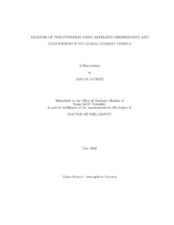| dc.description.abstract | In this study, the space-time relationship of precipitation fields is examined by testing the Taylor's "frozen field" hypothesis (TH). Specifically, the hypothesis supposes that if a spatio-temporal precipitation field with a stationary covariance
Cov(r,tau) in both space r and time tau, moves with a constant velocity v, then the temporal covariance at time lag tau is equal to the spatial covariance at space lag v tau, that is, Cov(0;tau) = Cov(v tau, 0). Of specific interest is whether there is a cut-off or decorrelation time scale for which the TH holds for a given mean
flow velocity v. The validity of the TH is tested for precipitation fields using high-resolution gridded
NEXRAD radar reflectivity data over southeastern United States by employing two different statistical approaches. The first method is based upon rigorous hypothesis
testing while the second is based on a simple correlation analysis, which neglects possible dependencies in the correlation estimates. The data-set has an approximate
horizontal resolution of 4 km x 4 km and a temporal resolution of 15 minutes, while the time period of study is 4 days. The results of both statistical methods suggest
that the TH might hold for the shortest space and time scales resolved by the data (4 km and 15 minutes), but that it does not hold for longer periods or larger spatial
scales.
The fidelity of global climate models in accurately simulating seasonal mean precipitation in the tropics is investigated by comparisons with satellite observations. Specifically, six-year long (2000-2005) simulations are performed using a high-resolution (36-km) Weather Research Forecast (WRF) model and the Community
Atmosphere Model (CAM) at T85 spatial resolution and the results are compared with satellite observations from the Tropical Rainfall Measuring Mission (TRMM). The primary goal is to study the annual cycle of rainfall over four land regions of the tropics namely, the Indian monsoon, the Amazon, tropical Africa and the North American monsoon. The results indicate that the WRF model systematically underestimates the magnitude of monthly mean rainfall over most Tropical land regions but
gets the seasonal timing right. On the other hand, CAM produces rainfall magnitudes that are closer to the observations but the rainfall peak leads or lags the observations by a month or two. Some of these regional biases can be attributed to erroneous circulation and moisture surpluses/deficits in the lower troposphere in both models. Overall, the results seem to indicate that employing a higher spatial resolution (36 km) does not significantly improve simulation of precipitation. We speculate that a combination of several physics parameterizations and lack of model tuning gives rise
to the observed differences between the models and the observations. | en |


